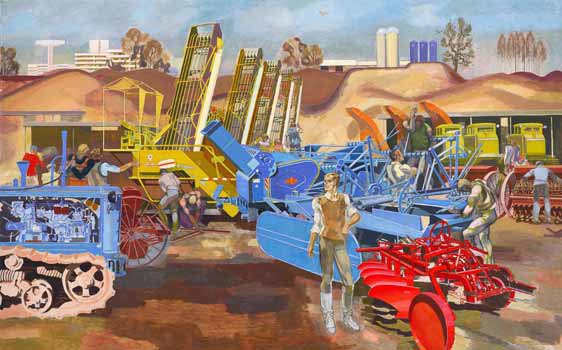Two exhibitions
dal 26/1/2013 al 20/4/2013
Segnalato da
Vladimirs Andrijenko
Aleksandra Briede
Janis Briedis
Aleksejs Fjodorovs
Semjons Gelbergs
Tenis Grasis
Edgars Iltners
Eduards Kalnins
Mihails Korneckis
Emils Melderis
Gunars Mitrevics
Anna Nollendorfa
Janis Osis
Livija Rezevska
Herberts Silins
Dzemma Skulme
Aleksandrs Stankevics
Rita Valnere
Daniel Canogar
26/1/2013
Two exhibitions
BildMuseet, Umea
Soviet Mythology in Latvian Art is an exhibition of paintings and sculptures from the period 1945-1985; art was strictly regulated and the job of the artist was to articulate the ideals of communism. The installations of the Spanish artist Daniel Canogar make new use of outdated technologies: celluloid 35 mm film, VHS tapes and analogue television screens.

Soviet Mythology in Latvian Art
Soviet Mythology in Latvian Art is an exhibition of paintings and sculptures from the period 1945-1985. It focuses on socialist realism as an art movement shaped by ideology and as a part of the Soviet political programme. Art was strictly regulated and the job of the artist was to articulate the ideals of communism. The myths that were formulated were about the happy Soviet society and the sense of duty, diligence and bravery of the Soviet people.
The exhibition displays pieces by Vladimirs Andrijenko, Aleksandra Briede, Jānis Briedis, Aleksejs Fjodorovs, Semjons Gelbergs, Tenis Grasis, Edgars Iltners, Eduards Kalniņš, Mihails Korņeckis, Emīls Melderis, Gunārs Mitrēvics, Anna Nollendorfa, Jānis Osis, Līvija Rezevska, Herberts Siliņš, Džemma Skulme, Aleksandrs Stankēvičs and Rita Valnere.
Soviet Mythology in Latvian Art is curated by Elita Ansone and is produced by Bildmuseet in collaboration with the Latvian National Museum of Art in Riga, Latvia.
---------
Daniel Canogar
Quadratura
The rapid technical development of the film medium is an inspiration for the Spanish artist Daniel Canogar. His installations make new use of outdated technologies: celluloid 35 mm film, VHS tapes and analogue television screens. The piece Sikka Magnum, which was specially produced for Bildmuseet, consists of over three hundred DVDs. Films are projected onto their reflective surfaces and mirrored across the room as a mosaic.
The works of Daniel Canogar comments on man’s relationship to the technological development, and on the changes in memory and identity caused by constant upgrades. He imagines that the dated media he uses represents these lost memories and identities. Quadratura refers to the Renaissance technique to create three-dimensional effects on plane surfaces.
Daniel Canogar (born 1964) works with photography, video, sculpture and installation. This exhibition is his first solo exhibition in Scandinavia.
For further information, please contact
Cecilia Andersson, curator Bildmuseet 090-786 6684, 072-223 8671 cecilia.andersson@bildmuseet.umu.se
BildMuseet
Umea universitet, Ostra Strandgatan 26, Umea
Hours: Tues: 11-20, Wed-Sun 11-18
Admission is free



